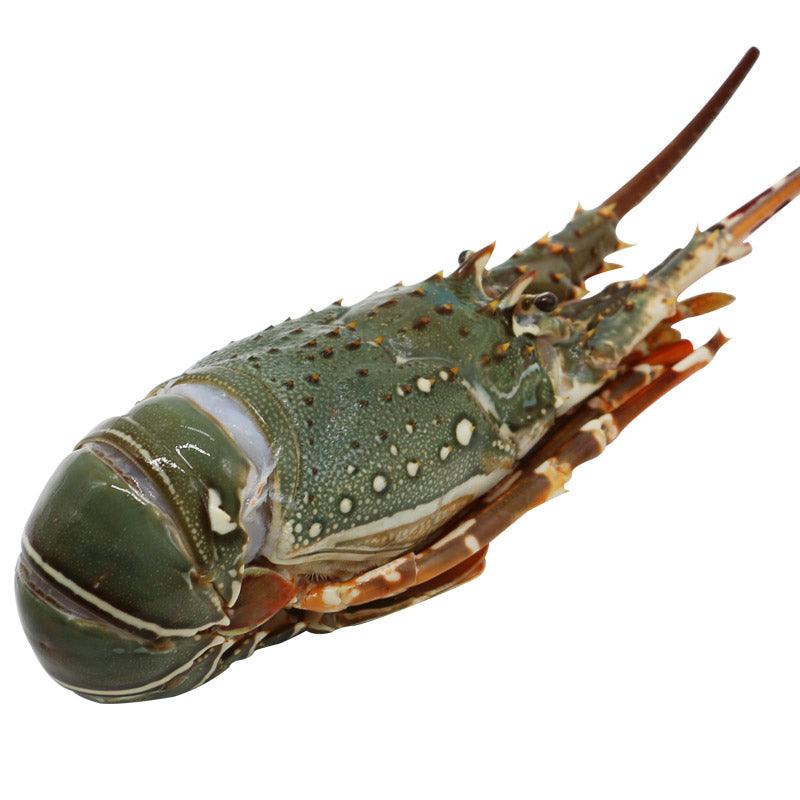Fish Club
Green Lobster / 青龙虾
Green Lobster / 青龙虾
SKU:GLB-W-234
Out of stock
Couldn't load pickup availability
- Origin: India / 产地:印度
- Wild Caught / 野生捕捞
- Preservatives Free / 不含防腐
- For best quality, consume within 3 months from purchase / 购买后3个月内食用,品质最佳
Weight includes 10% ice glazing 波纹龙虾(Panulirus homarus,俗称青龙,青壳仔,沙龙)
▲全身呈青绿色,很易分辨,市场常见的多为本地龙,其余也有来自斯里兰卡、南亚海域及其它地方。 主要产地: 香港大鹏湾、西贡、东平洲一带、斯里兰卡、南亚海域。 食用季节: 全年供应,农历六七月当造。 海鲜特点: 青龙每只约 1 斤多,比澳洲龙细,但贵一倍多,只因外壳薄肉爽而甜,味道香,胜过其它龙虾。 烹饪:青龙卖相美观,时尚高级餐厅必备食材,深得总厨青睐。因为虾母特别多膏,出品时最适合做蒜茸蒸,也可出品芝士局和刺身,肉质鲜嫩无比。
How To Make: Grilled Lobster with Garlic-Parsley Butter

Ingredients
- 8 tbsp. unsalted butter, softened
- 2 tbsp. finely chopped parsley
- 1 1⁄2 tsp. crushed red chile flakes
- 4 cloves garlic, finely chopped
- Zest of 1 lemon
- Kosher salt and freshly ground black pepper, to taste
- 1 live lobster (about 1 to 1 1/2 lb.)
- 1⁄4 cup olive oil
Steps
- Combine butter, parsley, chile flakes, garlic, lemon zest, salt, and pepper in a bowl; set aside. Using a cleaver, split lobster in half lengthwise through its head and tail. Scoop out and discard the yellow-green tomalley and break off claws. Transfer lobster halves, shell side down, to a baking sheet; crack claws and place them on the baking sheet. Drizzle halves and claws with oil, and season with salt and pepper.
- Heat a charcoal grill or set a gas grill to high; bank coals or turn off burner on one side (see "Grilling 101"). Place lobster halves, flesh side down, and claws on hottest part of grill; cook until slightly charred, 2-3 minutes. Flip lobster over and using a spoon, spread lobster with the garlic-parsley butter; continue grilling until lobster meat is tender, 3-5 minutes more.
Also Try: Grilled Lobster with Bloody Mary Linguine
Sources: https://www.saveur.com/grilled-lobster-with-garlic-parsley-butter-recipe/
Additional Information:
Caution: Customized cutting is NOT available.注意:恕不接受客制化切割
Storage: Keep frozen at -18°C. For best quality, consume within 3 months.
储存方式:冷冻雪藏 -18°C。购买后3个月内食用,品质最佳。
✅ 100% Preservative Free 绝无防腐
✅ Cleaned & Gutted 去鳞清内脏
✅ Vacuum Packed 真空包装
✅ Flash Frozen 急速冷冻
How we package your order?
How we package your order?
The vacuum sealed seafood products and frozen chill packs, which contain non-toxic gel are packed in a polystyrene box, so the chill packs distribute the cold evenly throughout your fish and seafood, ensuring maximum freshness.
We seal the polystyrene box with packing tape and hand it to our cold chain logistic to deliver to you.
What should I do when my order arrives?
What should I do when my order arrives?
Remove your seafood products as soon as possible from the box, refrigerate all fresh items and freeze all frozen goods until you are ready to prepare them for consumption.
How is your frozen seafood handled? What is your freezing process?
How is your frozen seafood handled? What is your freezing process?
Our fish and shellfish are processed and immediately frozen in our -45°c blast freezer. No chemicals or preservatives are added during the freezing or production process on any of our seafood items.
What is a -45 Degree Freezer and how does it affect the seafood when defrosted?
What is a -45 Degree Freezer and how does it affect the seafood when defrosted?
Blast freezing seafood products at a lower temperature keeps the wall of the cell intact, ensuring that water from the inside does not exit. When defrosted, the quality, texture, and appearance will remain completely intact just as if it were a fresh product.
What is the proper way to defrost frozen seafood products?
What is the proper way to defrost frozen seafood products?
If you have received frozen seafood and placed it in the freezer, remove these items from the freezer and store them in the refrigerator for at least one day before you plan to serve it. Allow 12 to 24 hours for the product to properly defrost. Do not rush the defrosting process as it can affect the flavor and texture of your seafood.
Why are some seafood products unavailable from time-to-time?
Why are some seafood products unavailable from time-to-time?
The availability of seafood products depends upon the season, weather, and other conditions that can affect a catch or harvest. Additionally, the harvesting of many seafood products is regulated in order to maintain a sustainable supply.


